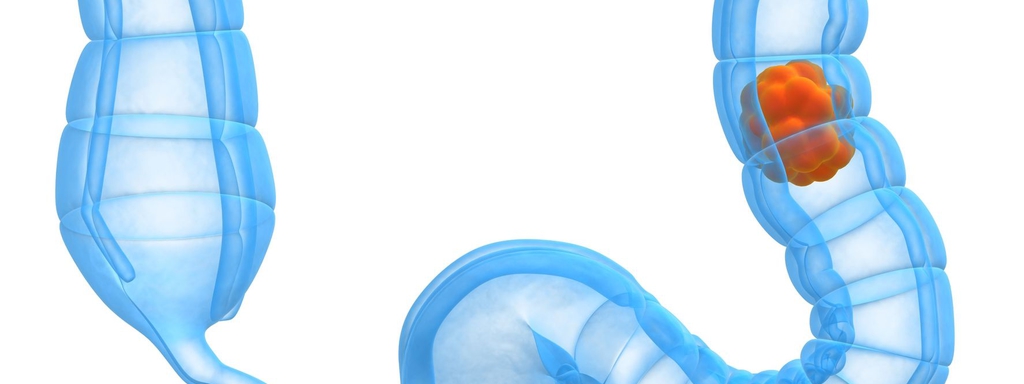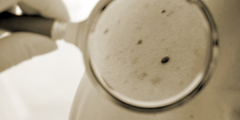
Ecologische en andere observationele studies laten zien dat zowel de blootstelling aan uvB als de vitamine D-status invers gerelateerd is aan het voorkomen van zo’n 15 - 20 types kanker. Het meest bekend is de van de zuid naar noord toenemende incidentie van colon- en borstkanker in de VS.1-3 Het vitamine D-hormoon 1,25-dihydroxyvitamine D [1,25(OH)2D] en analoga hiervan remmen de nieuwvorming van tumoren in de darmen van proefdieren.4 Dierstudies hebben eveneens laten zien dat vitamine D-suppletie en de chronische behandeling met vitamine D-receptoragonisten de ontwikkeling remmen van tumoren van de huid, colon, prostaat en de borstklier.5 De bewijzen voor een preventieve rol in mensen zijn echter nog zwak. Observationele studies laten een tamelijk consistente rol zien van vitamine D in zowel de preventie als de overleving van diverse soorten kanker. De huidige drie gerandomiseerde interventiestudies (RCTs) die niet primair gericht waren op kanker als eindpunt zijn echter negatief.4,6 Dat geldt ook voor een recente RCT die kanker als primair eindpunt onderzocht.7
Beste bezoeker, u heeft geen toegang.
Enkel (web)abonnees hebben toegang tot tijdschriftartikelen. Het webabonnement is nog in de maak.
U kunt zich wel alvast (gratis) registreren en tal van andere webartikelen raadplegen!
Auteur
Trefwoorden:
Verschenen in
Referenties
Grant WB, Boucher BJ. Randomized controlled trials of vitamin D and cancer incidence: A modeling study. PLoS One. 2017 May 1;12(5):e0176448.
Garland CF, Garland FC, Gorham ED, Lipkin M, Newmark H, Mohr SB, Holick MF. The role of vitamin D in cancer prevention. Am J Public Health. 2006 Feb;96(2):252-61.
Moukayed M, Grant WB. The roles of UVB and vitamin D in reducing risk of cancer incidence and mortality: A review of the epidemiology, clinical trials, and mechanisms. Rev Endocr Metab Disord. 2017 Jun;18(2):167-182.
Pereira F, Larriba MJ, Muñoz A. Vitamin D and colon cancer. Endocr Relat Cancer. 2012 May 3;19(3):R51-71.
Welsh J. Cellular and molecular effects of vitamin D on carcinogenesis. Arch Biochem Biophys. 2012 Jul 1;523(1):107-14.
Jacobs ET, Kohler LN, Kunihiro AG, Jurutka PW. Vitamin D and Colorectal, Breast, and Prostate Cancers: A Review of the Epidemiological Evidence. J Cancer. 2016 Jan 5;7(3):232-40.
Lappe J, Watson P, Travers-Gustafson D, Recker R, Garland C, Gorham E, Baggerly K, McDonnell SL. Effect of Vitamin D and Calcium Supplementation on Cancer Incidence in Older Women: A Randomized Clinical Trial. JAMA. 2017 Mar 28;317(12):1234-1243.
Yin L, Ordóñez-Mena JM, Chen T, Schöttker B, Arndt V, Brenner H. Circulating 25-hydroxyvitamin D serum concentration and total cancer incidence and mortality: a systematic review and meta-analysis. Prev Med. 2013 Dec;57(6):753-64.
Porojnicu AC, Dahlback A, Moan J. Sun exposure and cancer survival in Norway: changes in the risk of death with season of diagnosis and latitude. Adv Exp Med Biol. 2008;624:43-54.
Godar DE. Worldwide increasing incidences of cutaneous malignant melanoma. J Skin Cancer. 2011;2011:858425.
Crombie IK. Distribution of malignant melanoma on the body surface. Br J Cancer. 1981 Jun;43(6):842-9.
Dixon KM, Tongkao-On W, Sequeira VB, Carter SE, Song EJ, Rybchyn MS, Gordon-Thomson C, Mason RS. Vitamin D and death by sunshine. Int J Mol Sci. 2013 Jan 18;14(1):1964-77.
Godar DE, Landry RJ, Lucas AD. Increased UVA exposures and decreased cutaneous Vitamin D(3) levels may be responsible for the increasing incidence of melanoma. Med Hypotheses. 2009 Apr;72(4):434-43.
Dennis LK, Vanbeek MJ, Beane Freeman LE, Smith BJ, Dawson DV, Coughlin JA. Sunburns and risk of cutaneous melanoma: does age matter? A comprehensive meta-analysis. Ann Epidemiol. 2008 Aug;18(8):614-27.
Nilsen LT, Hannevik M, Veierød MB. Ultraviolet exposure from indoor tanning devices: a systematic review. Br J Dermatol. 2016 Apr;174(4):730-40.
Autier P, Doré JF, Eggermont AM, Coebergh JW. Epidemiological evidence that UVA radiation is involved in the genesis of cutaneous melanoma. Curr Opin Oncol. 2011 Mar;23(2):189-96.
Grant WB. How strong is the evidence that solar ultraviolet B and vitamin D reduce the risk of cancer?: An examination using Hill's criteria for causality. Dermatoendocrinol. 2009 Jan;1(1):17-24.
Smith GC, Pell JP. Parachute use to prevent death and major trauma related to gravitational challenge: systematic review of randomised controlled trials. BMJ. 2003 Dec 20;327(7429):1459-61
Latov N. Evidence-based guidelines: Not recommended. Journal of American Physicians and Surgeons 2005;10:18-9.
Eddy DM. Evidence-based medicine: a unified approach. Health Aff (Millwood). 2005 Jan-Feb;24(1):9-17.
Atkins D. Creating and synthesizing evidence with decision makers in mind: integrating evidence from clinical trials and other study designs. . Med Care. 2007 Oct;45(10 Supl 2):S16-22
Rawlins M. De testimonio: on the evidence for decisions about the use of therapeutic interventions. Lancet. 2008 Dec 20;372(9656):2152-61.
Williams BA. Perils of evidence-based medicine. Perspect Biol Med. 2010 Winter;53(1):106-20.
Raad voor Volksgezondheid en Samenleving. Zonder context geen bewijs. Over de illusie van evidence-based practice in de zorg. Den Haag, juni 2017, Xerox/OBT, Publicatie 17-05. ISBN: 987-90-5732-267-9 https://www.zorgvisie.nl/PageFiles/103563/WEB_103526_adv17%20(2).pdf
Anonymous. What conclusions has Clinical Evidence drawn about what works, what doesn't based on randomised controlled trial evidence? http://clinicalevidence.bmj.com/x/set/static/cms/efficacy-categorisation....
Blumberg J, Heaney RP, Huncharek M, Scholl T, Stampfer M, Vieth R, Weaver CM, Zeisel SH. Evidence-based criteria in the nutritional context. Nutr Rev. 2010 Aug;68(8):478-84.
Keum N, Giovannucci E. Vitamin D supplements and cancer incidence and mortality: a meta-analysis. Br J Cancer. 2014 Aug 26;111(5):976-80.
Manson JE, Bassuk SS, Buring JE. Vitamin D, Calcium, and Cancer: Approaching Daylight? JAMA. 2017 Mar 28;317(12):1217-1218.
Jenab M, Bueno-de-Mesquita HB, Ferrari P, van Duijnhoven FJ, Norat T, Pischon T, Jansen EH et al. Association between pre-diagnostic circulating vitamin D concentration and risk of colorectal cancer in European populations: a nested case-control study. BMJ. 2010 Jan 21;340:b5500.
Bristow SM1, Bolland MJ, MacLennan GS, Avenell A, Grey A, Gamble GD, Reid IR. Calcium supplements and cancer risk: a meta-analysis of randomised controlled trials. Br J Nutr. 2013 Oct;110(8):1384-93.
Pradhan AD, Manson JE. Update on the Vitamin D and OmegA-3 trial (VITAL). J Steroid Biochem Mol Biol. 2016 Jan;155(Pt B):252-6.
Manson JE1, Bassuk SS, Lee IM, Cook NR, Albert MA, Gordon D, Zaharris E, Macfadyen JG, Danielson E, Lin J, Zhang SM, Buring JE.The VITamin D and OmegA-3 TriaL (VITAL): rationale and design of a large randomized controlled trial of vitamin D and marine omega-3 fatty acid supplements for the primary prevention of cancer and cardiovascular disease. Contemp Clin Trials. 2012 Jan;33(1):159-71.
Vitamin D and Omega-3 Trial (VITAL) (VITAL). ClinicalTrials.gov. https://clinicaltrials.gov/ct2/show/NCT01169259
Norman AW, Bouillon R. Vitamin D nutritional policy needs a vision for the future. Exp Biol Med (Maywood). 2010 Sep;235(9):1034-45.
Harinarayan CV. Vitamin D and diabetes mellitus. Hormones (Athens). 2014 Apr-Jun;13(2):163-81.
Morris HA, Anderson PH. Autocrine and paracrine actions of vitamin D. Clin Biochem Rev. 2010 Nov;31(4):129-38.
Cross HS, Nittke T, Kallay E. Colonic vitamin D metabolism: implications for the pathogenesis of inflammatory bowel disease and colorectal cancer. Mol Cell Endocrinol. 2011 Dec 5;347(1-2):70-9.
Bischoff-Ferrari H.A. Optimal serum 25-hydroxyvitamin D levels for multiple health outcomes. Chapter 5, pp 55-71. In: Sunlight, Vitamin D and Skin Cancer (Reichrath ed). Springer Science+Business Media, LLC Landes Bioscience 2008, ISBN 978-0-387-77574-6.
Gröschel C, Tennakoon S, Kállay E. Cytochrome P450 Vitamin D Hydroxylases in Inflammation and Cancer. Adv Pharmacol. 2015;74:413-58.
Bostick RM. Effects of supplemental vitamin D and calcium on normal colon tissue and circulating biomarkers of risk for colorectal neoplasms. J Steroid Biochem Mol Biol. 2015 Apr;148:86-95.
Fedirko V, Bostick RM, Flanders WD, Long Q, Sidelnikov E, Shaukat A, Daniel CR, Rutherford RE, Woodard JJ. Effects of vitamin d and calcium on proliferation and differentiation in normal colon mucosa: a randomized clinical trial. Cancer Epidemiol Biomarkers Prev. 2009 Nov;18(11):2933-41.
Aggarwal A, Höbaus J, Tennakoon S, Prinz-Wohlgenannt M, Graça J, Price SA, Heffeter P, Berger W, Baumgartner-Parzer S, Kállay E. Active vitamin D potentiates the anti-neoplastic effects of calcium in the colon: A cross talk through the calcium-sensing receptor. J Steroid Biochem Mol Biol. 2016 Jan;155(Pt B):231-8.
Klampfer L. Vitamin D and colon cancer. World J Gastrointest Oncol. 2014 Nov 15;6(11):430-7.
Feldman D, Krishnan AV, Swami S, Giovannucci E, Feldman BJ. The role of vitamin D in reducing cancer risk and progression. Nat Rev Cancer. 2014 May;14(5):342-57.
Li Y, Casey SC, Felsher DW. Inactivation of MYC reverses tumorigenesis. J Intern Med. 2014 Jul;276(1):52-60.
Meeker S1, Seamons A1, Maggio-Price L1, Paik J. Protective links between vitamin D, inflammatory bowel disease and colon cancer. World J Gastroenterol. 2016 Jan 21;22(3):933-48.
Hopkins MH, Owen J, Ahearn T, et al. Effects of supplemental vitamin D and calcium on biomarkers of inflammation in colorectal adenoma patients: a randomized, controlled clinical trial. Cancer Prev Res (Phila) 2011;4(10):1645-1654
Welsh J. Function of the vitamin D endocrine system in mammary gland and breast cancer. Mol Cell Endocrinol. 2017 Sep 15;453:88-95.
Fleet JC, DeSmet M, Johnson R, Li Y. Vitamin D and cancer: a review of molecular mechanisms. Biochem J. 2012 Jan 1;441(1):61-76.
Ditsch N, Toth B, Mayr D, Lenhard M, Gallwas J, Weissenbacher T, Dannecker C, Friese K, Jeschke U. The association between vitamin D receptor expression and prolonged overall survival in breast cancer. J Histochem Cytochem. 2012 Feb;60(2):121-9.
Jones G, Prosser DE, Kaufmann M. 25-Hydroxyvitamin D-24-hydroxylase (CYP24A1): its important role in the degradation of vitamin D. Arch Biochem Biophys. 2012 Jul 1;523(1):9-18.
Höbaus J, Fetahu ISh, Khorchide M, Manhardt T, Kallay E. Epigenetic regulation of the 1,25-dihydroxyvitamin D3 24-hydroxylase (CYP24A1) in colon cancer cells. J Steroid Biochem Mol Biol. 2013 Jul;136:296-9.
Höbaus J, Hummel DM, Thiem U, Fetahu IS, Aggarwal A, Müllauer L, Heller G, Egger G, Mesteri I, Baumgartner-Parzer S, Kallay E. Increased copy-number and not DNA hypomethylation causes overexpression of the candidate proto-oncogene CYP24A1 in colorectal cancer. Int J Cancer. 2013 Sep 15;133(6):1380-8.
Sakaki T, Yasuda K, Kittaka A, Yamamoto K, Chen TC. CYP24A1 as a potential target for cancer therapy. Anticancer Agents Med Chem. 2014 Jan;14(1):97-108.
Morris HA, Anderson PH. Autocrine and paracrine actions of vitamin d. Clin Biochem Rev. 2010 Nov;31(4):129-38.
Hollis BW, Wagner CL The Role of the Parent Compound Vitamin D with Respect to Metabolism and Function: Why Clinical Dose Intervals Can Affect Clinical Outcomes. J Clin Endocrinol Metab. 2013 Dec;98(12):4619-28.
Garland CF, Gorham ED, Mohr SB, Garland FC. Vitamin D for cancer prevention: global perspective. Ann Epidemiol. 2009 Jul;19(7):468-83.
Chen GC, Zhang ZL, Wan Z, Wang L, Weber P, Eggersdorfer M, Qin LQ, Zhang W. Circulating 25-hydroxyvitamin D and risk of lung cancer: a dose-response meta-analysis. Cancer Causes Control. 2015 Dec;26(12):1719-28.
Holick MF. Vitamin D and sunlight: strategies for cancer prevention and other health benefits. Clin J Am Soc Nephrol. 2008 Sep;3(5):1548-54.
Stubbins RE1, Hakeem A, Núñez NP. Using components of the vitamin D pathway to prevent and treat colon cancer. Nutr Rev. 2012 Dec;70(12):721-9.
Maalmi H, Ordóñez-Mena JM, Schöttker B, Brenner H. Serum 25-hydroxyvitamin D levels and survival in colorectal and breast cancer patients: systematic review and meta-analysis of prospective cohort studies. Eur J Cancer. 2014 May;50(8):1510-21.
Ou B, Zhao J, Guan S, Lu A. Plasma 25-hydroxyvitamin D levels and survival of colorectal cancer patients: a meta-analysis. Eur J Cancer. 2015 Apr;51(6):786-8.
Wang B, Jing Z, Li C, Xu S, Wang Y. Blood 25-hydroxyvitamin D levels and overall mortality in patients with colorectal cancer: a dose-response meta-analysis. Eur J Cancer. 2014 Aug;50(12):2173-5.
Mohr SB, Gorham ED, Kim J, Hofflich H, Cuomo RE, Garland CF. Could vitamin D sufficiency improve the survival of colorectal cancer patients? J Steroid Biochem Mol Biol. 2015.
Maalmi H, Walter V, Jansen L, Chang-Claude J, Owen RW, Ulrich A, Schöttker B, Hoffmeister M, Brenner H. Relationship of very low serum 25-hydroxyvitamin D3 levels with long-term survival in a large cohort of colorectal cancer patients from Germany. Eur J Epidemiol. 2017 Sep 7. [Epub ahead of print]
Rooney MR, Harnack L, Michos ED, Ogilvie RP, Sempos CT, Lutsey PL. Trends in Use of High-Dose Vitamin D Supplements Exceeding 1000 or 4000 International Units Daily, 1999-2014. JAMA. 2017 Jun 20;317(23):2448-2450.
Vieth R. Vitamin D and cancer mini-symposium: the risk of additional vitamin D. Ann Epidemiol. 2009 Jul;19(7):441-5.
Vieth R. Vitamin D and cancer mini-symposium: the risk of additional vitamin D. Ann Epidemiol. 2009 Jul;19(7):441-5.
Schlingmann KP1, Kaufmann M, Weber S, Irwin A, Goos C, John U, Misselwitz J, Klaus G, Kuwertz-Bröking E, Fehrenbach H, Wingen AM, Güran T, Hoenderop JG, Bindels RJ, Prosser DE, Jones G, Konrad M. Mutations in CYP24A1 and idiopathic infantile hypercalcemia. N Engl J Med. 2011 Aug 4;365(5):410-21.
Scientific Opinion on the Tolerable Upper Intake Level of vitamin D1 EFSA Panel on Dietetic Products, Nutrition and Allergies (NDA). EFSA Journal 2012;10(7):2813.
Adams JS, Liu PT, Chun R, Modlin RL, Hewison M. Vitamin D in defence of the human immune response. Ann N Y Acad Sci. 2007; 1117: 94-105.
Kavathia D, Buckley JD, Rao D, Rybicki B, Burke R. Elevated 1, 25-dihydroxyvitamin D levels are associated with protracted treatment in sarcoidosis. Respir Med. 2010; 104: 564-570.
Maalouf N. Hypercalcemia in granulomatous diseases. UpToDate. https://www.uptodate.com/contents/hypercalcemia-in-granulomatous-diseases. Accessed 01 Nov 2017.
Holick MF. Vitamin D deficiency. N Engl J Med. 2007; 357: 266-281
Zimmermann A. Vitamin D in preventive medicine: are we ignoring the evidence? Br J Nutr. 2003; 89: 552-572.
Bischoff-Ferrari HA, Dawson-Hughes B, Orav EJ, Staehelin HB, Meyer OW, Theiler R, Dick W, Willett WC, Egli A. Monthly High-Dose Vitamin D Treatment for the Prevention of Functional Decline: A Randomized Clinical Trial. JAMA Intern Med. 2016 Feb;176(2):175-83.
Dawson-Hughes B, Mithal A, Bonjour JP, Boonen S, Burckhardt P, Fuleihan GE, Josse RG, Lips P, Morales-Torres J, Yoshimura N. IOF position statement: vitamin D recommendations for older adults. Osteoporos Int. 2010 Jul;21(7):1151-4.
Gallagher JC1, Sai A, Templin T 2nd, Smith L. Dose response to vitamin D supplementation in postmenopausal women: a randomized trial. Ann Intern Med. 2012 Mar 20;156(6):425-37.
Snijder MB, van Dam RM, Visser M, Deeg DJ, Dekker JM, Bouter LM, Seidell JC, Lips P Adiposity in relation to vitamin D status and parathyroid hormone levels: a population-based study in older men and women. J Clin Endocrinol Metab. 2005 Jul;90(7):4119-23.
Vieth R. Vitamin D supplementation, 25-hydroxyvitamin D concentrations, and safety. Am J Clin Nutr. 1999 May;69(5):842-56.
Muskiet FAJ, Schuitemaker GE, Van der Veer E, Wielders JPM. Een kritische beschouwing van de aanbevelingen en de rationale van het Gezondheidsraad rapport ‘Evaluatie van de voedingsnormen voor vitamine D’. Ned Tijdschr Klin Chem Labgeneesk 2013; 38: 169-185.
Steingrimsdottir L1, Gunnarsson O, Indridason OS, Franzson L, Sigurdsson G. Relationship between serum parathyroid hormone levels, vitamin D sufficiency, and calcium intake. JAMA. 2005 Nov 9;294(18):2336-41.
Bolland MJ, Grey A, Gamble GD, Reid IR. Calcium and vitamin D supplements and health outcomes: a reanalysis of the Women's Health Initiative (WHI) limited-access data set. Am J Clin Nutr. 2011 Oct;94(4):1144-9.
Michaëlsson K, Melhus H, Warensjö Lemming E, Wolk A, Byberg L. Long term calcium intake and rates of all cause and cardiovascular mortality: community based prospective longitudinal cohort study. BMJ. 2013 Feb 12;346:f228.
EFSA Panel on Dietetic Products, Nutrition and Allergies (NDA). Scientific Opinion on Dietary Reference Values for calcium. EFSA Journal 2015;13(5):4101.
EFSA Panel on Dietetic Products, Nutrition and Allergies (NDA). Scientific Opinion on the Tolerable Upper Intake Level of calcium. EFSA Journal 2012;10(7):2814
Reid IR, Bristow SM, Bolland MJ. Cardiovascular complications of calcium supplements. J Cell Biochem. 2015 Apr;116(4):494-501.
Reid IR, Bolland MJ. Calcium risk-benefit updated—new WHI analyses. Maturitas 2014;77:1-3.
Reid IR, Bolland MJ, Avenell A, Grey A. Cardiovascular effects of calcium supplementation. Osteoporos Int. 2011 Jun;22(6):1649-58
Reid IR, Bolland MJ. Calcium supplements: bad for the heart? Heart. 2012 Jun;98(12):895-6
Bolland MJ, Grey A, Reid IR. Are more trials of calcium supplements really needed? Osteoporos Int. 2017 Jul 7. doi: 10.1007/s00198-017-3988-1. [Epub ahead of print].
Garland CF, Grant WB, Boucher BJ, Cross HS, Garland FC, Gillie O, Gorham ED, Heaney RP, Holick MF, Hollis BW, Moan JE, Peterlik M, Reichrath J, Zittermann A. Open letter to IARC Director Christopher P. Wild-Re: IARC Working Group Report 5: Vitamin D and Cancer. Dermatoendocrinol. 2009 Mar;1(2):119-20.





